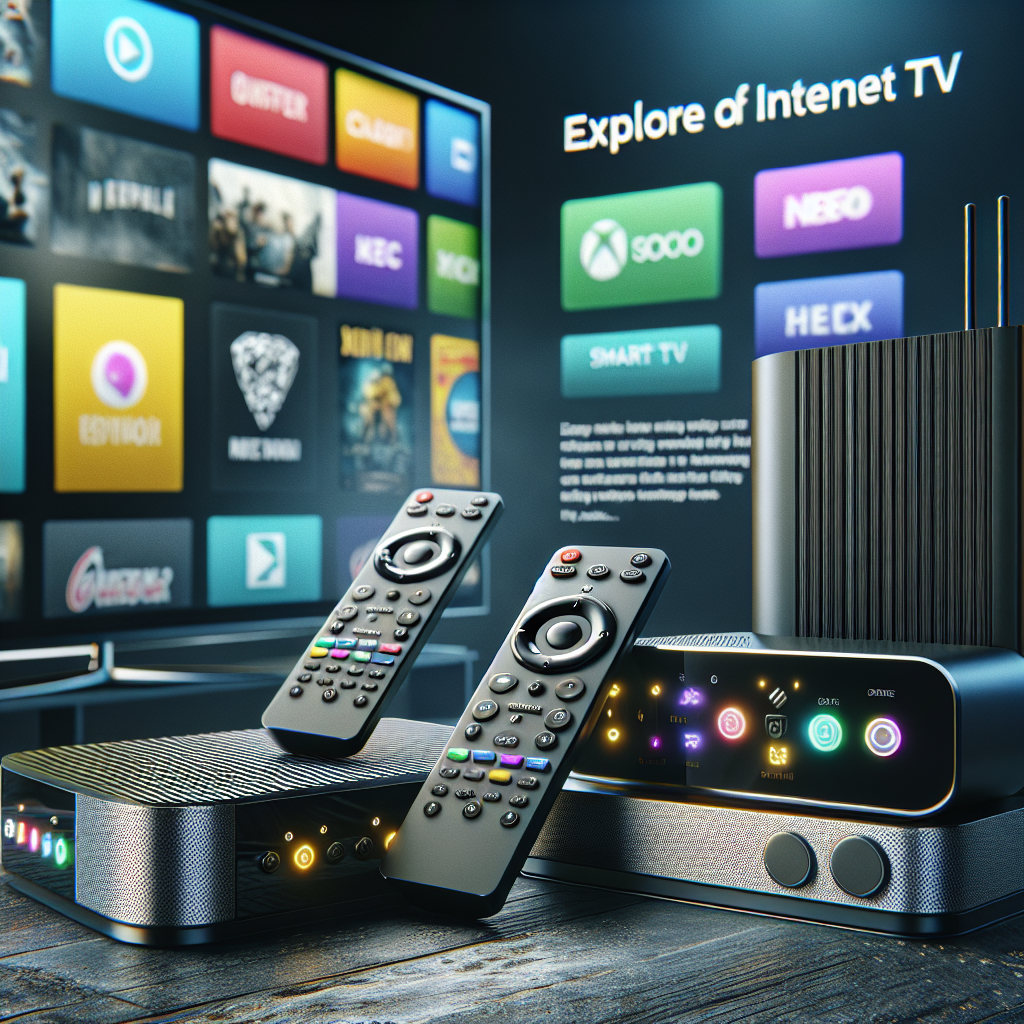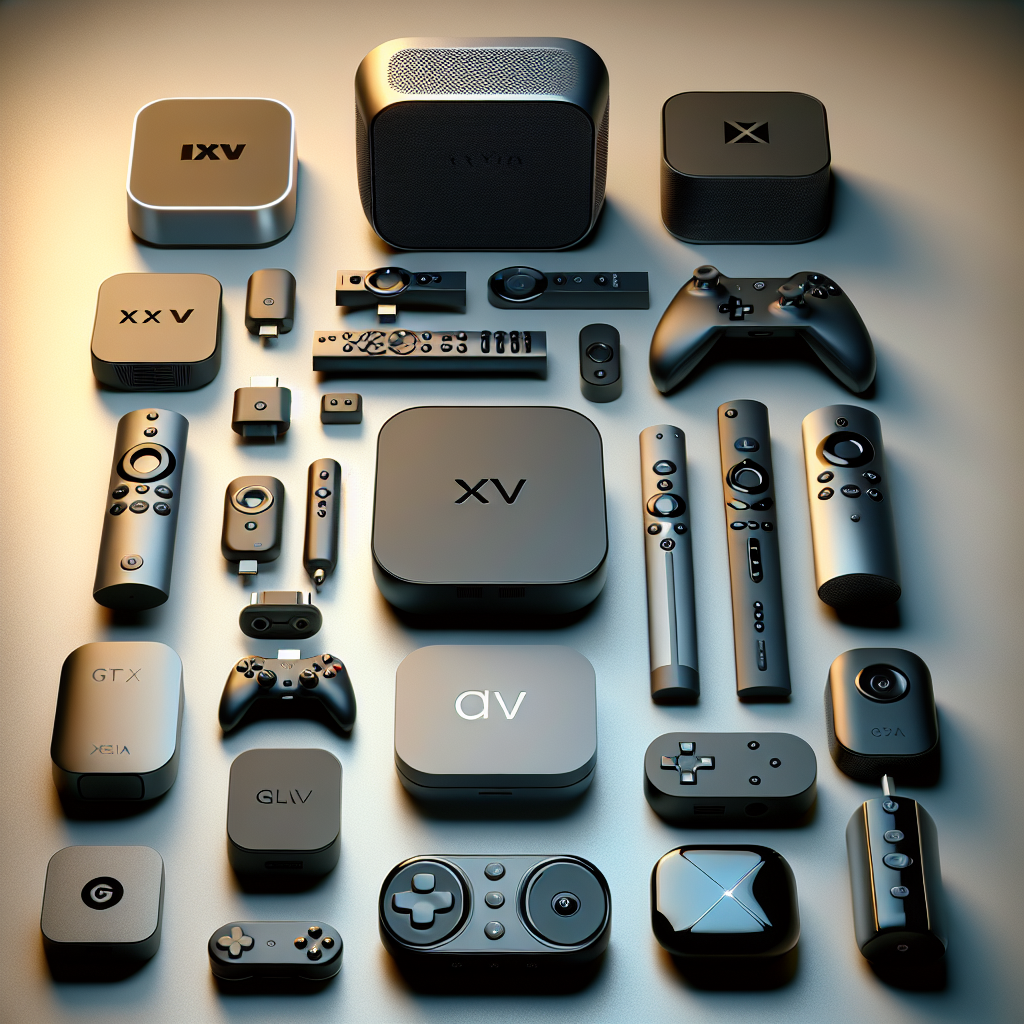Welcome to the exciting world of Internet TV devices designed for smart TVs! In this modern age of technology, the way we consume television has evolved, and these devices are at the forefront of this revolution. Internet TV devices allow you to access a plethora of streaming services, apps, and content directly on your smart TV, without the need for a separate cable box or satellite dish. From popular options like Roku and Apple TV to more specialized devices like Amazon Fire Stick and Chromecast, there is a device to suit every viewing preference. Join us as we delve into the endless possibilities and conveniences of Internet TV devices for smart TVs.
For businesses, these devices offer unique opportunities to reach customers in innovative ways. With the rise of streaming platforms and smart TV integration, companies can explore advertising through apps, create branded content for platforms like YouTube or Hulu, or even develop their own streaming apps to engage with their audience directly. As Internet TV devices continue to shape consumer habits, businesses that adapt to these trends can position themselves at the forefront of digital engagement and entertainment marketing.
Understanding Internet TV Devices

Internet TV devices, also known as streaming media players, are small devices that connect to your smart TV to provide access to online streaming content. These devices come equipped with various apps and services that allow users to stream movies, TV shows, music, and more directly onto their television screens. They serve as a bridge between the internet and your TV, bringing a world of entertainment right into your living room.
Definition of Internet TV Devices
Internet TV devices are hardware devices that enable users to stream digital content from the internet onto their televisions. They typically connect to the TV through an HDMI port and require an internet connection to access online streaming services such as Netflix, Hulu, Amazon Prime Video, and YouTube. Popular examples of internet TV devices include Roku, Amazon Fire TV, Apple TV, and Google Chromecast.
How Internet TV Devices Enhance Smart TVs
Internet TV devices enhance the functionality of smart TVs by providing access to a wide range of streaming services and apps that may not be pre-installed on the TV itself. They offer users the flexibility to customize their entertainment options based on their preferences, whether it’s watching movies on Netflix, catching up on the latest TV shows on Hulu, or listening to music on Spotify.
By connecting an internet TV device to a smart TV, users can transform their regular television into a smart entertainment hub with access to a vast library of online content. Additionally, internet TV devices often come with advanced features such as voice control, 4K streaming capabilities, and integration with smart home devices, further enhancing the overall viewing experience.
Benefits of Internet TV Devices
- Access to a wide range of streaming services: Internet TV devices for smart TVs provide users with access to a plethora of streaming services, including popular platforms like Netflix, Hulu, Amazon Prime Video, and more. This allows viewers to enjoy a diverse selection of movies, TV shows, documentaries, and original content from various providers, catering to different preferences and interests.
- Ability to customize viewing preferences: One of the key benefits of internet TV devices is the ability to customize viewing preferences according to individual tastes. Users can create personalized watchlists, set up profiles for different family members, receive tailored recommendations based on viewing history, and even explore niche content genres that align with their specific interests. This level of customization enhances the overall viewing experience by ensuring that users have easy access to the content they enjoy the most.
- Enhanced viewing experience with 4K and HDR support: Internet TV devices often come equipped with advanced features such as support for 4K resolution and High Dynamic Range (HDR) technology. This means that users can enjoy a higher quality viewing experience with sharper images, vibrant colors, and improved contrast levels. Whether watching the latest blockbuster movie or streaming a nature documentary, the enhanced visual quality provided by 4K and HDR support adds a new dimension to the viewing experience, making it more immersive and engaging.
Types of Internet TV Devices
Streaming Media Players
Streaming media players are stand-alone devices that connect to your Smart TV to stream content from various online platforms. These devices typically come with a remote control and offer access to popular streaming services such as Netflix, Hulu, and Amazon Prime Video. Some popular streaming media players include Roku, Apple TV, and Amazon Fire TV.
Smart TV Boxes
Smart TV boxes are devices that can turn your regular TV into a Smart TV by providing access to internet-based content and services. These boxes usually run on specific operating systems such as Android TV or Roku OS, allowing users to download apps, stream videos, and browse the internet directly on their TV screens. Examples of Smart TV boxes include Nvidia Shield TV and Xiaomi Mi Box.
HDMI Sticks
HDMI sticks, also known as streaming sticks, are compact devices that plug directly into the HDMI port of your TV. These devices are usually powered by a USB connection or an external power adapter and offer similar functionality to streaming media players. Popular HDMI sticks include Google Chromecast and Amazon Fire TV Stick, which allow users to cast content from their smartphones or tablets to the TV screen.
Comparison of Popular Internet TV Devices
ypes of Internet TV Devices
When it comes to Internet TV devices for smart TVs, there are several popular options available in the market. Let’s take a closer look at the key features and functionalities of some of the leading devices:
- Roku
- Roku offers a wide range of models catering to different needs and budgets.
- It provides access to a vast selection of streaming services and channels.
- The user-friendly interface and remote make it easy to navigate and control.
- Roku devices support 4K streaming on compatible TVs for an enhanced viewing experience.
- Amazon Fire TV Stick
- The Amazon Fire TV Stick is known for its integration with Alexa voice control.
- It offers a variety of apps and games in addition to streaming services.
- The device supports 1080p HD streaming and also has 4K options available for higher resolution content.
- Amazon Fire TV Stick provides personalized recommendations based on viewing history.
- Apple TV
- Apple TV stands out for its seamless integration with other Apple devices and services.
- It offers access to Apple’s exclusive content through Apple TV+.
- The device supports 4K HDR streaming for stunning picture quality.
- Apple TV features a sleek design and a touch-sensitive remote for easy navigation.
- Google Chromecast
- Google Chromecast is known for its simplicity and affordability.
- It allows users to cast content from their smartphones or computers to the TV screen.
- Chromecast supports 1080p streaming and also offers a 4K Ultra version for higher resolution playback.
- The device can be controlled using a smartphone, making it convenient for users.
Each of these popular Internet TV devices has its strengths and unique features, catering to different preferences and requirements of users looking to enhance their smart TV viewing experience.

Setting Up Internet TV Devices
Internet TV devices are becoming increasingly popular as they offer a wide range of streaming options and services to enhance the entertainment experience. Setting up these devices with your smart TV is a relatively simple process that can be done by following a few key steps:
- Connecting the device to the smart TV:
- Begin by identifying the HDMI port on your smart TV where the internet TV device will be connected.
- Insert one end of the HDMI cable into the HDMI port on the internet TV device and the other end into the HDMI port on the smart TV.
- Ensure that both devices are powered on and set to the correct input source on the TV.
- Installation and setup process:
- Once the internet TV device is connected to the smart TV, follow the on-screen instructions to complete the initial setup process.
- This typically involves connecting the device to your home Wi-Fi network and creating or logging into your account for the streaming services you wish to access.
- Some devices may require software updates during the setup process, so it is important to ensure that the device is connected to the internet to download any necessary updates.
- Troubleshooting common setup issues:
- If you encounter any issues during the setup process, refer to the user manual or online support resources provided by the manufacturer.
- Common setup issues may include network connectivity problems, incorrect input source selected on the TV, or compatibility issues with the smart TV.
- Restarting both the internet TV device and the smart TV, as well as power cycling your home Wi-Fi router, can often resolve minor setup issues.
Optimizing Internet TV Device Performance
Setting Up Internet TV Devices
Internet TV devices are powerful tools that can enhance your viewing experience, but to ensure optimal performance, it is crucial to take proactive steps to optimize their functionality. Here are some key strategies to consider:
- Updating firmware and apps: Regularly updating the firmware and apps on your internet TV device is essential for maintaining optimal performance. These updates often include bug fixes, security patches, and new features that can enhance your viewing experience. By staying up to date with the latest software releases, you can ensure that your device operates smoothly and efficiently.
- Managing storage and memory usage: Internet TV devices, like any electronic device, have limitations when it comes to storage and memory. To optimize performance, it is important to regularly monitor and manage the storage and memory usage on your device. Deleting unnecessary apps, files, and data can help free up space and improve overall performance. Additionally, consider using external storage options to expand the capacity of your device if needed.
- Ensuring a stable internet connection: A stable internet connection is crucial for streaming content on your smart TV through an internet TV device. To optimize performance, ensure that your device is connected to a reliable and high-speed internet network. If you experience buffering, lagging, or other connectivity issues, consider troubleshooting your network or contacting your internet service provider for assistance. By maintaining a stable internet connection, you can enjoy seamless streaming and a superior viewing experience.
Security and Privacy Considerations
In the ever-evolving landscape of Internet TV devices, it is crucial to address the security and privacy considerations that come hand in hand with these innovative technologies. Ensuring the protection of personal data and safeguarding against cyber threats should be at the forefront of users’ minds when utilizing smart TVs with Internet capabilities.
Data Privacy Concerns with Internet TV Devices
- Data Collection: Internet TV devices often collect user data, including viewing habits, search history, and device usage patterns. This data can be valuable for targeted advertising but raises concerns about user privacy.
- Third-Party Sharing: Many Internet TV devices share user data with third-party companies for various purposes, such as improving services or delivering personalized content. Users should be cautious about the extent to which their data is shared and for what purposes.
Securing Your Device from Cyber Threats
- Regular Updates: Keeping Internet TV devices up to date with the latest software updates is essential for patching security vulnerabilities and ensuring optimal protection against cyber threats.
- Strong Passwords: Setting strong, unique passwords for Internet TV devices can prevent unauthorized access and protect sensitive information stored on the device.
Best Practices for Protecting Personal Information
- Limit Data Sharing: Reviewing and adjusting privacy settings on Internet TV devices to limit the collection and sharing of personal information can help mitigate privacy risks.
- Use Secure Networks: Connecting Internet TV devices to secure, password-protected networks can prevent unauthorized access and data breaches.
- Monitor Permissions: Regularly reviewing and managing the permissions granted to apps and services on Internet TV devices can enhance data security and privacy.
Tips for Safely Using Internet TV Devices
- Using strong passwords: When setting up your Internet TV device, it is crucial to create a strong and unique password to prevent unauthorized access. Avoid using easily guessable passwords like “123456” or “password.” Opt for a combination of letters, numbers, and special characters to enhance the security of your device.
- Disabling unnecessary features: Take the time to review the settings on your Internet TV device and disable any features that you do not use regularly. Unnecessary features can potentially serve as entry points for cyber threats. By disabling them, you reduce the attack surface of your device and minimize the risk of security breaches.

– Regularly checking for software updates: Keep your Internet TV device up to date by regularly checking for software updates. Manufacturers often release updates to address security vulnerabilities and improve the overall performance of the device. By staying current with the latest software versions, you ensure that your device is equipped with the necessary protections against emerging threats.
Future Trends in Internet TV Devices
In the rapidly evolving landscape of Internet TV devices, several future trends are shaping the way we interact with our smart TVs. These trends not only enhance user experience but also pave the way for a more connected and intuitive viewing environment.
Integration of Voice Assistants
One of the key advancements in Internet TV devices is the integration of voice assistants such as Amazon Alexa, Google Assistant, and Apple’s Siri. This feature allows users to control their smart TVs using voice commands, making it easier to search for content, adjust settings, and even interact with other smart home devices seamlessly.
Advancements in AI Technology for Personalized Recommendations
AI technology is playing a significant role in enhancing the content discovery experience on Internet TV devices. Through sophisticated algorithms, these devices can analyze user preferences, viewing habits, and even mood to offer personalized recommendations. This level of customization not only saves time but also ensures that users are exposed to content that aligns with their interests.
Expansion of Smart Home Connectivity with Internet TV Devices
As smart homes become more prevalent, Internet TV devices are increasingly being designed to integrate with other smart home devices and systems. This allows users to control their lighting, thermostat, security cameras, and more directly from their smart TV interface. The seamless connectivity between Internet TV devices and smart home technology creates a more cohesive and convenient living environment for users.
FAQs: Exploring the World of Internet TV Devices for Smart TVs
What are Internet TV devices for smart TVs?
Internet TV devices are devices that allow you to stream content from the internet directly to your smart TV. These devices typically connect to your TV via HDMI and provide access to popular streaming services such as Netflix, Hulu, and Amazon Prime Video.
What are some popular Internet TV devices?
Some popular Internet TV devices for smart TVs include Roku, Apple TV, Amazon Fire TV, and Google Chromecast. These devices offer a wide range of features such as voice control, 4K streaming, and access to a variety of streaming services.
How do Internet TV devices enhance the viewing experience on smart TVs?
Internet TV devices offer a wide range of benefits for smart TV users, including access to a vast library of streaming content, the ability to stream live TV, and features such as voice search and personalized recommendations. These devices also typically provide a more user-friendly interface for accessing and navigating content on your smart TV.
Can Internet TV devices work with any smart TV?
Most Internet TV devices are compatible with a wide range of smart TVs, regardless of the brand or operating system. However, it’s always a good idea to check the compatibility of a specific device with your TV before making a purchase to ensure seamless integration and optimal performance.
